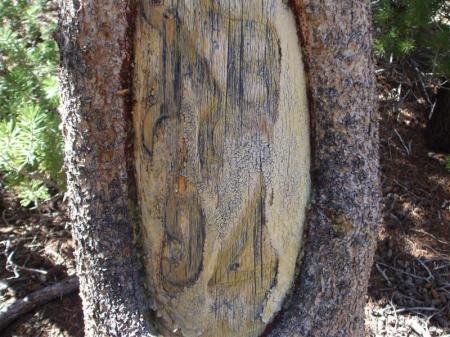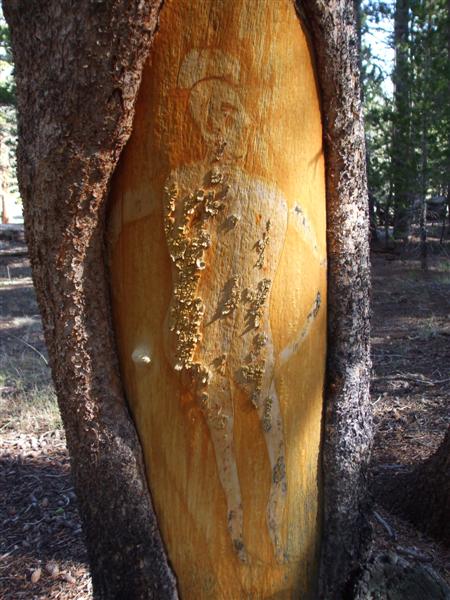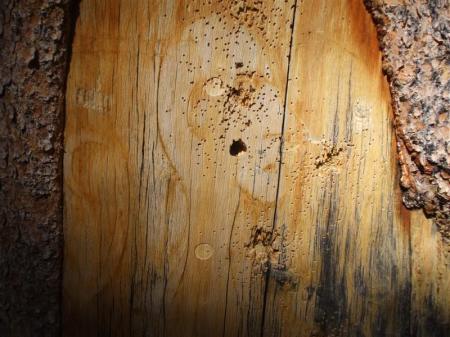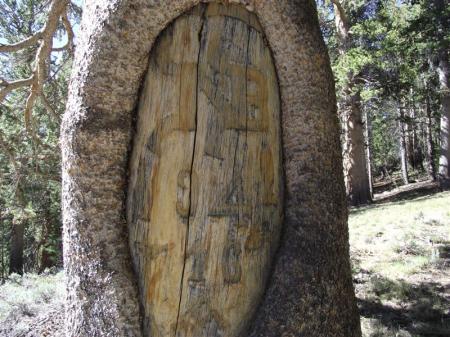It was purely by chance that I stumbled across one of my greatest discoveries in life, the arborglyphs of the Eastern Sierra. I started out hunting for pioneer and Indian relics as a young boy and was fascinated by the history of the West. I still go back to those boyhood days every time I go out exploring with my dog. It makes me feel like a school kid on Saturday morning.
I walked by the silent tree carvings for twenty five years not knowing they were there watching me from their tree trunks. Then, one day while eating lunch in the meadow at my favorite spot on the Tamarack Bench at Rock Creek Lake, I noticed some small pieces of purple glass and a Levi Strauss button on the ground. Looking up in the trees I noticed some carvings. Then, on a downed tree, I saw a date of 1892. I was so excited and amazed at this find that I began to research and explore the entire area for new arborglyphs. It became a passion as I morphed into a full on glypher. I now live to promote their value as important historical cultural treasures from our nations past. 
There really are no records about how long people have been carving on trees. The types of people who would have left their mark in the American West included: trappers, explorers, settlers, stockmen, Indians, surveyors, miners, woodcutters and the cavalry.
I learned that the carvings on the Tamarack Bench were mostly from Basque sheepherders with the possibility of an Irishman thrown in for good measure. They were the ones who came to America in the Gold Rush of 1849 and started the sheep range business all over the West. By the 1880s they worked their way over to the Eastern Sierra and started a green gold rush of their own by grazing every mountain meadow they could get their hooves into. When those meadows were wet, they left devastation in their wake that will take hundreds of years to recover. That is the dark side of the arborglyphs that we admire today.
It’s lucky for us that pioneers left their mark on the trees around the meadows where they grazed their stock. It is all that is left to represent their entire life time. Upon looking at their graven images one can relate to their human desires of a lonely heart searching for love, companionship and sex. Some left entire last names like Lombard, Juillet and Bresson, as well as dates from the 1880s to 1896.
This was during the Victorian era and the carvers were careful not to show any nude depictions of women that would become so common with the pornographic images that future shepherds would carve as societal morals decayed. On the other hand the shepherds thought it perfectly okay to depict themselves naked with a large display of their manhood. Another common theme was a top hat, smoking cigarettes or a pipe. The women of their day are depicted with bustles, bows and bizarre hair.
Grazing activity reached a peak in 1896 in the Eastern Sierra and continues to this day with shepherds from Peru and Chile. Every year they leave their name and date on the trees where they work.
After finding those original glyphs on the Bench, I went on to find many more images in Rock Creek Canyon and Bishop Creek Canyon. I have no idea how many more are out there. That will be left up to the future glyphers of America to discover and wonder about.
Arborglyphs on aspen trees number in the tens of thousands. The carvings on lodgepole trees on the Tamarack Bench are far more rare and in their own class for research. In fact, arborglyph experts like Chris Worrell from Ohio have verified that these particular glyphs are a national treasure.
One summer I returned to the groves of arborglyphs on the Bench and found a new trail running through the area that the commercial mule packers made to pack in fishing parties. They were in a battle with the environmentalists and the forest service to increase stock use in the Eastern Sierra wilderness. They chose to increase their use by camping just outside the wilderness boundary in the exact spot that the arborglyphs are located. This was all very upsetting for me and I contacted the forest service, environmentalists, wrote editorials and talked to many people about it. For political reasons the forest service would not respond because of the lawsuit.
The lawsuit lasted eight years and the forest service was finally defeated in the Superior Court of San Francisco. This was after they spent $7.5 million on a failed wilderness plan designed to increase commercial stock use. That whole ordeal left the packers angry to this day. Nothing ever changed on the Bench and the same trail runs through there as a permanent fixture.
On the positive side, during the lawsuit, teams of specialists were sent out to survey the wilderness and among them were archeologists. They recorded many of the arborglyphs on the Bench which were placed on a map in case of fire. 
Many of the arborglyphs are fading away due to weather erosion. The bark has worn off, and the knife lines are disappearing into the golden color of the elderly lodgepole trees. Some of the trees have blown down with their carvings facing the ground never to be seen again. One carving from 1896 was blasted by a careless individual with a shotgun. They also threw an axe at it for target practice. Even pesky woodpeckers and beavers can do a number on arborglyphs. The worst enemy is fire.
So like Chris Worrell always says, “Photograph, document and record,” before the arborglyphs fade away forever. This is our window of opportunity to provide future arborglyph researchers with the images they may never be able to see in the wild. Next time you are out wandering in the woods, take a look around at the trees to see if they have any stories to tell you. Don’t leave home without your camera and have fun glyphing.




















